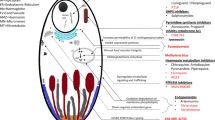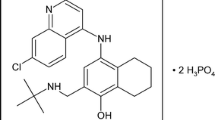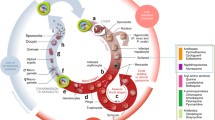Summary
Although more than 40% of the world’s population live in malaria endemic areas, there are only 6 available antimalarial drugs for the treatment of Plasmodium falciparum infections. Three of these have been developed in the last 20 years and are discussed in this review.
Mefloquine is relatively well tolerated and has the advantage of a single day regimen. It has ideal properties for prophylactic use. However, although rare, serious adverse reactions do occur and the drug cannot be used in severe malaria. Resistance has already emerged in some parts of the world.
Halofantrine is also well tolerated and has a rapid antimalarial activity. It is more expensive than other antimalarials and the existence of cross-resistance links its usefulness to the demise of mefloquine. The discovery of a potentially lethal cardiotoxicity associated with halofantrine casts a further shadow over its use.
The artemisinin derivatives represent an exciting breakthrough in the treatment of malaria. They are cheap and have a very rapid action. They seem remarkably free from toxic adverse effects, although the neurotoxicity seen in animal studies with the liposoluble derivatives gives rise for concern. However, the lack of pharmacokinetic and toxicity data as yet preclude their approval by Western drug regulation authorities.
All antimalarials are threatened by the emergence of parasite resistance. Combination therapy using mefloquine and an artemisinin derivative may provide a way in which resistance can be combated.
Similar content being viewed by others
References
Stürchler D. How much malaria is there worldwide? Parasitol Today 1989; 5: 39
Pinichpongse S. Regimens for treating Plasmodium falciparum in Thailand. Bull World Health Organ 1982; 60: 907–12
Bjorkman A, Phillips-Howard PA. The epidemiology of drug-resistant malaria. Trans R Soc Trop Med Hyg 1990; 84: 177–80
White NJ. Antimalarial drug resistance: the pace quickens. J Antimicrob Chemother 1992; 30: 571–85
Palmer KJ, Holliday SM, Brogden RN. Mefloquine. A review of its antimalarial activity, pharmacokinetic properties and therapeutic efficacy. Drugs 1993; 45: 430–75
Schmidt LH, Crosby R, Rasco J, et al. Antimalarial activities of various 4-quinolinemethanols with special attention to WR-142 490 (mefloquine). Antimicrob Agents Chemother 1978; 13: 1011–30
Karbwang J, White NJ. Clinical pharmacokinetics of mefloquine. Clin Pharmacokinet 1990; 19: 264–79
Boudreau EF, Fleckenstein L, Pang LW, et al. Mefloquine kinetics in cured and recrudescent patients with acute falciparum malaria and in healthy volunteers. Clin Pharmacol Ther 1990; 48: 399–409
Karbwang J, Na Bangchang K, Thanavibul A, et al. Pharmacokinetics of mefloquine in treatment failure. Southeast Asian J Trop Med Public Health 1991; 22: 523–6
ter Kuile FO, Luxemburger C, Nosten F, et al. Predictors of mefloquine treatment failure: a prospective study in 1590 patients with uncomplicated falciparum malaria. Bull World Health Organ. In press
ter Kuile FO, Teja-Isavatharm P, Luxemburger C, et al. Mefloquine concentrations in 183 patients with acute falciparum malaria: evidence for dose limited oral bioavailability. In: ter Kuile F. Mefloquine, halofantrine, artemisinin in the treatment of uncomplicated falciparum malaria in a multi-drug resistant area [PhD thesis]. Amsterdam: University of Amsterdam
Navaratnam V, Mohamad M, Mansor SM, et al. Pharmacokinetics of mefloquine: comparison of two commercial formulations. 13th International Congress of Tropical Medicine and Malaria. Jomtien, Pattaya, Thailand: 1992 29 Nov–4 Dec. Abstract ThP13-13: 281
Singhasivanon V, Chongsuphajaisiddhi T, Sabcharoen A, et al. Pharmacokinetics of mefloquine in children aged 6 to 24 months. Eur J Drug Metab Pharmacokinet 1992; 17: 275–9
Nosten F, Karbwang J, White NJ, et al. Mefloquine antimalarial prophylaxis in pregnancy: dose finding and pharmacokinetics. Br J Clin Pharmacol 1990; 30: 79–85
Pennie RA, Koren G, Crevoisier C. Steady state pharmacokinetics of mefloquine in long-term travellers. Trans R Soc Trop Med Hyg 1993; 87: 459–62
Nosten F, Luxemburger C, ter Kuile FO, et al. Optimum artesunate-mefloquine combination for the treatment of multidrug resistant P. falciparum malaria. J Infect Dis 1994; 170:971–7
Fontanet AL, Johnston DB, Walker AM, et al. High prevalence of mefloquine-resistant falciparum malaria in eastern Thailand. Bull World Health Organ 1993; 71: 377–83
Suebsaeng L, Wernsdorfer WH, Rooney W. Sensitivity to quinine and mefloquine of Plasmodium falciparum in Thailand. Bull World Health Organ 1986; 64(5): 759–65
Wongsrichanalai C, Webster WH, Wimonwattrawatee T, et al. Emergence of multidrug-resistant Plasmodium falciparum in Thailand: in vitro tracking. Am J Trop Med Hyg 1992; 47: 112–6
Lobel HO, Bernard KW, Williams SL, et al. Effectiveness and tolerance of long-term malaria prophylaxis with mefloquine. Need for a better dosing regimen. JAMA 1991; 265: 361–4
Tin F, Hlaing N, Lasserre R. Single-dose treatment of falciparum malaria with mefloquine: field studies with different doses in semi-immune adults and children in Burma. Bull World Health Organ 1982; 60: 913–7
Ekue JMK, Ulrich AM, Rwabwogo-Atenyi J, et al. A double blind comparative clinical trial of mefloquine and chloroquine in symptomatic falciparum malaria. Bull World Health Organ 1983; 61: 713–8
ter Kuile FO, Dolan G, Nosten F, et al. Halofantrine versus mefloquine in the treatment of multi-drug resistant falciparum malaria. Lancet 1993; 341: 1044–9
Cowan GO, Pany ES. Choroquine-resistant Plasmodium falciparum malaria in the United Kingdom. Lancet 1968; 2: 946–8
ter Kuile FO, Nosten F, Luxemburger C, et al. Mefloquine treatment of acute falciparum malaria: a prospective study of adverse effects in 3673 patients. Bull World Health Organ. In press
Luxemburger C, Nosten F, ter Kuile FO, et al. Mefloquine for multidrug-resistant malaria [letter]. Lancet 1991; 338: 1268
Steffen R, Fuchs E, Schildknecht J, et al. Mefloquine compared with other malaria chemoprophylactic regimens in tourists visiting east Africa. Lancet 1993; 341: 1299–303
Nosten F, te Kuile FO, Luxemburger C, et al. Cardiac effects of antimalarial treatment with halofantrine. Lancet 1993; 341: 1054–6
ter Kuile FO, Nosten F, Luxemburger C, et al. Monitoring the therapeutic response to antimalarials: a classification of mefloquine resistance. In: ter Kuile F. Mefloquine, halofantrine, artemisinin in the treatment of uncomplicated faciparum malaria in a multidrug resistant area [PhD thesis]. Amsterdam: University of Amsterdam
Halofantrine in the treatment of malaria [editorial]. Lancet 1989; 2: 537–8
Brasseur P, Bitsindou P, Moyou RS, et al. Fast emergence of Plasmodium falciparum resistance to halofantrine [letter]. Lancet 1993; 341: 901–2
Watkins W, Oloo J. Efficacy of multi-dose halofantrine in the treatment of chloroquine resistant falciparum malaria in children in Kenya. Lancet 1988; 2: 247–50
Monlun E, Leenhardt A, Pillet O, et al. Ventricular arrhythmia and halofantrine intake. Probable deleterious effect. Apropos of 3 cases. Bull Soc Pathol Exot 1993; 86: 365–7
Molun E, Pillet O, Cochard JF, et al. Prolonged QT interval with halofantrine [letter]. Lancet 1993; 341: 1541–2
Klayman DL. Qinghaosu. An antimalarial drug from China. Science 1985; 228: 1049–55
Jiang JB, Li GQ, Gao XB, et al. Antimalarial activity of mefloquine and qinghaosu. Lancet 1982; 2: 285–8
China Cooperative Research Group on qinghaosu and its derivatives. Chemical studies on qinghaosu (artemisinin). J Tradit Chin Med 1994; 2: 3–8
Meshnick SR, Yang YZ, Lima V, et al. Iron-dependent free radical generation from the antimalarial agent artemisinin (qinghaosu). Antimicrob Agents Chemother 1993; 37: 1108–14
Qinghaosu Antimalaria Coordinating Group. Antimalarial studies on qinghaosu. Chin Med J 1979; 92: 811–6
White NJ. Clinical pharmacokinetics and pharmacodynamics of artemisinin and derivatives. Trans R Soc Trop Med Hyg 1994; 88 Suppl.: 41–3
Bangchang KN, Karbwang J, Thomas CG, et al. Pharmacokinetics of artemether after oral administration to healthy Thai males and patients with acute, uncomplicated falciparum malaria. Br J Clin Pharmacol 1994; 37: 249–53
Hien TT, White NJ. Qinghaosu: drug profile. Lancet 1993; 341: 603–8
Li GQ, Arnold K, Guo XB, et al. Randomised comparative study of mefloquine, qinghaosu, and pyrimethamine-sulfadoxine in patients with falciparum malaria. Lancet 1984; 2: 1360–1
Myint PT. Comparative study of artemether versus standard antimalarials in Plasmodium falciparum. Burmese Med J 1985; 2: 36–43
Luxemburger C, ter Kuile FO, Nosten F, et al. Single day mefloquine-artesunate combination in the treatment of multi-drug resistant falciparum malaria. Trans R Soc Trop Med Hyg 1994; 88: 213–7
Shen JX. Antimalarial drug development in China. Beijing: National Institute of Pharmaceutical Research and Development, 1989: 31–95
Li GQ. Clinical trials on qinghaosu and its derivatives. Vol. 1. Guangzhou: Sanya Tropical Medicine Institute, 1990: 1–90
Brewer TG, Peggins JO, Grate SJ, et al. Neurotoxicity in animals due to arteether and artemether. Trans R Soc Trop Med Hyg 1994; 88 Suppl. 1: 33–6
Bunnag D, Viravan C. Double blind randomised clinical trial of oral artesunate at once or twice daily dose in falciparum malaria. Southeast Asian J Trop Med Public Health 1991; 22: 539–43
Bunnag D, Viravan C. Double blind randomised clinical trial of two different regimens of oral artesunate in falciparum malaria. Southeast Asian J Trop Med Public Health 1991; 22: 534–8
White NJ, Waller D, Crawley J, et al. A comparison of artemether and chloroquine for severe malaria in Gambian children. Lancet 1992; 339: 317–21
Hien TT, Phu NH, Mai NT, et al. An open randomized comparison of intravenous and intramuscular artesunate in severe falciparum malaria. Trans R Soc Trop Med Hyg 1992; 86: 584–5
Luxemburger C, Nosten F, Shorta N, et al. Oral artesunate in the treatment of uncomplicated hyperparasitaemic falciparum malaria. Am J Trop Med Hyg. In press
Taylor T, Wills B, Wirima JJ, et al. Artemether in cerebral malaria [letter]. Lancet 1993; 341: 1604
Hien TT, Arnold K, Vinh H, et al. Comparison of artemisinin suppositories with intravenous artesunate and intravenous quinine in the treatment of cerebral malaria. Trans R Soc Trop Med Hyg 1992; 86: 582–3
Arnold K. Early treatment of malaria in the community using artemisinin: hope or hazard? Trans R Soc Trop Med Hyg 1994; 88 Suppl. 1: 47–9
World Health Organization. The role of artemisinin and its derivatives in the current treatment of malaria. Report of an informal consultation convened in Geneva 27–29 September 1993.WHO/MAL/94.1067
Chawira AN. The effect of combinations of qinghaosu (artemisinin) with standard antimalarial drugs in the suppressive treatment of malaria in mice. Trans R Soc Trop Med Hyg 1987; 81: 554–8
Chawira AN, Warhurst DC. The effect of artemisinin combined with standard antimalarials against choloroquine-sensitive and choloroquine-resistant strains of plasmodium falciparum in vitro. J Trop Med Hyg 1987; 90: 1–8
Roche Tropical Medicine Unit. Qinghaosu and Lariam; therapeutic perspectives. Basel, Switzerland: F. Hoffman-La Roche Ltd, 1994
Looareesuwan S, Viravan C, Vanijanonta S, et al. Treatment of acute uncomplicated falciparum malaria with a short course of artesunate followed by mefloquine. Southeast Asian J Trop Med Public Health 1993; 24: 230–4
Looareesuwan S, Vanijanonta S, Viravan C, et al. Randomised trial of mefloquine alone and artesunate followed by mefloquine for the treatment of acute uncomplicated falciparum malaria. Ann Trop Med Parasitol. In press
Foster SD. Pricing, distribution, and use of antimalarial drugs. Bull World Health Organ 1991: 69(3): 349–63
Brasseur P, Kouamouo J, Moyou Somo R, et al. Multi-drug resistant falciparum malaria in Cameroon in 1987–1988. II. Mefloquine resistance confirmed in vivo and in vitro and its correlation with quinine resistance. Am J Trop Med Hyg 1992; 46: 8–14
Author information
Authors and Affiliations
Rights and permissions
About this article
Cite this article
Nosten, F., Price, R.N. New Antimalarials. Drug-Safety 12, 264–273 (1995). https://doi.org/10.2165/00002018-199512040-00006
Published:
Issue Date:
DOI: https://doi.org/10.2165/00002018-199512040-00006




